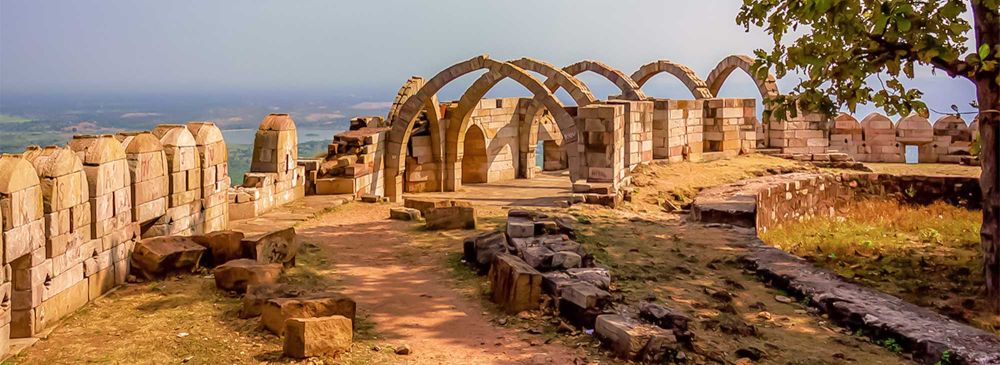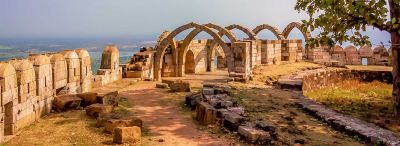

A UNESCO World Heritage Site, the Champaner-Pavagadh Archaeological Park is a treasure trove of historical and cultural significance. It blends both Islamic and Hindu architectural styles, showcasing untouched palaces, entrance gates, arches, and mosques. One of the most iconic structures to visit is the Jama Masjid, known for its intricate stone carvings and majestic presence. The park also encompasses the ancient Kalika Mata Temple, which is part of the larger temple complex at Pavagadh Hill. The archaeological park spans over an impressive six square kilometers, housing fortifications, palaces like the Rajput Palace, and residential precincts such as the Panch Mahal. Visitors can immerse themselves in history, take a guided tour, and marvel at the excellent condition of these 15th-century buildings. The blend of cultures is evident through the ruins, providing an in-depth look at the region's past.
Offering a mix of thrill and spirituality, the cable car ride to Pavagadh Hill is an activity that attracts tourists and pilgrims alike. Pavagadh Hill rises to a height of about 800 meters above sea level and is considered to be one of the oldest rock formations in India. The cable car, also known as the Udankhatola, provides breathtaking views of the below forested plateau and the historical structures of Champaner. Once at the top, visitors have the chance to visit the revered Kalika Mata Temple, which is said to be a Shakti Peetha, a major pilgrimage site for followers of Hinduism. The temple seamlessly combines myth, nature, and architecture, attracting hordes of devotees during the Chitra Vichitra fair. The ride itself takes only a few minutes, but the experience and the panoramic views it offers make it an unforgettable experience for anyone visiting Champaner.
The Helical Stepwell, also known as the 'Bawdi', in Champaner is an architectural marvel that silently narrates the tale of water management systems in ancient India. Unlike the typical stepwells which might feature straight, linear steps, this one is uniquely designed in a helical structure, spiraling down into the earth. This historical water storage system is known for its ingenious planning and the geometric precision of its spiral staircase. Although it was essentially utilitarian, built to provide water to the townsfolk, its design is very appealing to the eye. The Helical Stepwell is considered a superb example of this kind of structure, which is not only rare but distinctly displays the intelligence and skill of the artisans from the past. While visiting, one can feel the cool air descending into the well and marvel at the workmanship involved in creating such a sustainable and aesthetic structure in those times.
Photography enthusiasts will find Champaner to be a paradise with its captivating amalgamation of nature and historical architecture. One can embark on an exciting photography tour that takes through the picturesque ruins and landscapes of Champaner and Pavagadh. Capture the grandeur of the Jama Masjid, with its fine details and imposing façade, the fortifications with lush green backgrounds, or the vibrant local life and the rustic charm of the surroundings. Whether you're an amateur or a professional photographer, Champaner provides ample opportunities to click some splendid pictures. Moreover, the natural play of light at dawn and dusk enhances the beauty of these sites, offering magical moments for perfect shots. Visitors should keep their cameras at hand to seize the opportunity of capturing the stunning panorama from Pavagadh Hill and candid moments while exploring the local bazaars.
For adventure seekers, the trek up to Pavagadh Hill is both challenging and rewarding. It's a rugged terrain, balancing nature and spirituality, as the hill is not just an ecological hotspot but also a pilgrimage site. The trek through untamed forest, with chances to witness the flora and fauna, leads to the historical religious site of Kalika Mata Temple atop the hill. One gets to walk through the ancient gates and fort remnants that tell the story of a bygone era. The trek can be physically demanding due to the steep incline and uneven paths, so it's recommended for those with a reasonable level of fitness. Along the way, trekkers can admire the rocky landscape and scattered ruins before being greeted by a panoramic view of the surroundings. The trek thus offers a complex experience that's both a physical exercise and a visual treat for nature and history aficionados.
The 'Saat Kaman', or 'Seven Arches', is an intriguing historical landmark on Pavagadh Hill that draws visitors with its architectural uniqueness and historical significance. The structure consists of seven arches, and though it originally had ten, only seven remain today. The Saat Kaman was once part of the military fortification, providing a vantage point for guards to keep a watch on the region. This archway offers picturesque views of the surroundings, making it a popular spot for sightseeing and photography. Exploring the Saat Kaman and the adjacent areas gives visitors an insight into the strategic ingenuity of the time and the natural defenses leveraged in medieval fortresses. Due to its elevation, the wind here can be brisk, adding to the adventure of reaching and moving through the arches themselves.
The Nagina Masjid stands as an epitome of the architectural finesse attained in the 15th century, fashioned out of pure white stone. Though not as grand as the Jama Masjid, it carries its own elegance and charm. Located high up on the Pavagadh Hill, this mosque is sometimes referred to as the 'Jewel Mosque', consistent with its meaning 'Nagina' which means 'Jewel' in Urdu. Its simplicity contrasts with many other over-embellished monuments from this period, yet the mosque doesn't fail to impress with its unadulterated aesthetics. The mosque features minarets, a prayer hall with beautifully carved pillars and mihrab. This piece of architecture offers a quiet spot for contemplation amidst the bustling touristic sites. Its serene setting appeals to visitors looking for a place to rest and reflect on the rich history that surrounds them.
Vada Talav is a picturesque lake located near Champaner, and taking an evening stroll around its perimeter is a peaceful way to end a day of exploration. The tranquil expanse of water provides a scenic backdrop with the Pavagadh Hill looming in the distance. One can indulge in bird-watching as the lake draws various species, especially during the migratory seasons. The gentle breeze coming off the water is refreshing, particularly on warm evenings. Local vendors often set up stalls around the lake, offering snacks and refreshments, adding to the leisurely experience. The unhurried pace allows visitors to absorb the natural beauty of the area and capture some memorable photographs as the sun sets. This lake is not only a natural retreat but also a reflection of the area's ecological importance in a region marked by history and heritage.
